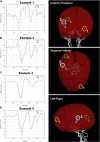Flow reversal in distal collaterals as a possible mechanism of delayed intraparenchymal hemorrhage after flow diversion treatment of cerebral aneurysms
- PMID: 35923225
- PMCID: PMC9339966
- DOI: 10.3389/fphys.2022.881627
Flow reversal in distal collaterals as a possible mechanism of delayed intraparenchymal hemorrhage after flow diversion treatment of cerebral aneurysms
Abstract
Background and Purpose: Delayed intraparenchymal hemorrhages (DIPHs) are one of the most serious complications of cerebral aneurysm treatment with flow diverters (FD), yet their causes are largely unknown. This study analyzes distal hemodynamic alterations induced by the treatment of intracranial aneurysms with FDs. Methods: A realistic model of the brain arterial network was constructed from MRA images and extended with a constrained constructive optimization technique down to vessel diameters of approximately . Different variants of the circle of Willis were created by alternatively occluding communicating arteries. Collateral vessels connecting different arterial trees were then added to the model, and a distributed lumped parameter approach was used to model the pulsatile blood flow in the arterial network. The treatment of an ICA aneurysm was modeled by changing the local resistance, flow inertia, and compliance of the aneurysmal segment. Results: The maximum relative change in distal pressure induced by the aneurysm treatment was below 1%. However, for certain combinations of the circle of Willis and distal collateralization, important flow reversals (with a wall shear stress larger than approximately ) were observed in collateral vessels, both ipsilaterally and contralaterally to the treated aneurysm. Conclusion: This study suggests the hypothesis that flow diverters treatment of intracranial aneurysms could cause important flow reversal in distal collaterals. Flow reversal has previously been shown to be pro-inflammatory and pro-atherogenic and could therefore have a detrimental effect on these collateral vessels, and thus could be a suitable explanation of DIPHs, while the small distal pressure increase is not.
Keywords: cerebral aneurysm; delayed intraparenchymal hemorrhage; flow diversion; flow reversal; mechanism.
Copyright © 2022 Hadad, Pradhan, Kadirvel, Kallmes, Cebral and Mut.
Conflict of interest statement
The authors declare that the research was conducted in the absence of any commercial or financial relationships that could be construed as a potential conflict of interest.
Figures





Similar articles
-
Flow diversion beyond the circle of Willis: endovascular aneurysm treatment in peripheral cerebral arteries employing a novel low-profile flow diverting stent.J Neurointerv Surg. 2019 Dec;11(12):1227-1234. doi: 10.1136/neurintsurg-2019-014840. Epub 2019 May 14. J Neurointerv Surg. 2019. PMID: 31088939 Free PMC article.
-
Color Doppler sonographic evaluation of collateral circulation in patients with cerebral aneurysms and the occlusion of the brachiocephalic vessels.Neurosurgery. 2005 Dec;57(6):1117-26; discussion 1117-26. doi: 10.1227/01.neu.0000186009.62401.3c. Neurosurgery. 2005. PMID: 16331159
-
Can the Windkessel Hypothesis Explain Delayed Intraparenchymal Haemorrhage After Flow Diversion? A Case Report and Model-Based Analysis of Possible Mechanisms.Heart Lung Circ. 2015 Aug;24(8):824-30. doi: 10.1016/j.hlc.2015.02.001. Epub 2015 Feb 17. Heart Lung Circ. 2015. PMID: 25804624
-
Braided stents and their impact in intracranial aneurysm treatment for distal locations: from flow diverters to low profile stents.Expert Rev Med Devices. 2019 Mar;16(3):237-251. doi: 10.1080/17434440.2019.1575725. Epub 2019 Feb 6. Expert Rev Med Devices. 2019. PMID: 30686064 Review.
-
Treatment of complex anterior cerebral artery aneurysms with Pipeline flow diversion: mid-term results.J Neurointerv Surg. 2017 Feb;9(2):147-151. doi: 10.1136/neurintsurg-2016-012519. Epub 2016 Jul 5. J Neurointerv Surg. 2017. PMID: 27382125 Review.
Cited by
-
Classification and hemodynamic characteristics of delayed intracerebral hemorrhage following stent-assisted coil embolism in unruptured intracranial aneurysms.Front Neurol. 2024 Feb 19;15:1268433. doi: 10.3389/fneur.2024.1268433. eCollection 2024. Front Neurol. 2024. PMID: 38440116 Free PMC article.
-
Innovations in intracranial aneurysm treatment: a pilot study on the Choydar flow diverter.Front Neurol. 2024 Jul 4;15:1413681. doi: 10.3389/fneur.2024.1413681. eCollection 2024. Front Neurol. 2024. PMID: 39026585 Free PMC article.
References
Grants and funding
LinkOut - more resources
Full Text Sources
Miscellaneous

